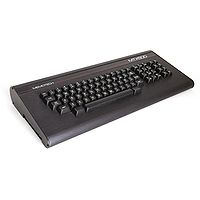- Memotech MTX
-
Memotech MTX
Memotech MTX500Manufacturer Memotech Release date 1983 CPU Zilog Z80A The Memotech MTX500, MTX512 and RS128 were a series of Zilog Z80A processor-based home computers released by Memotech in 1983 and 1984. They were technically similar to MSX computers, but were not compatible.
The MTX500 had 32KiB of RAM, the MTX512 had 64KiB, and the RS128 had 128KiB (a significant amount at that time). Although the Z80A could only address a maximum of 64KiB at a time, the MTX and RS128's extra memory, up to a maximum of 768KiB, was accessible through the technique of page switching. All models had 32KiB of ROM accessible in the first 24KiB of address space. The extra 8KiB of ROM was available through page switching. The ROM could be switched out entirely, allowing the full 16-bit address space to be used for RAM.
The computers featured an all-aluminium case and full size keyboard with real keys (unlike others of the same vintage such as the Sinclair ZX Spectrum). In addition to the standard (for the time) BASIC language interpreter, it included some interesting variations:
- A built-in assembler
- A built-in disassembler/debugger called Panel
- A forerunner of HyperCard called Noddy
- More sprites than the comparable equipment at the time
- Support for rudimentary windowing in BASIC
The computers also featured support for plug-in ROM cartridges (a little like the BBC Micro). The most popular of these was the ISO Pascal language from HiSoft which was much faster than interpreted BASIC. A considerable addition to any Memotech system was the hugely-expensive FDX system which added 5.25" floppy disk drives, Winchester hard disks and CP/M 2.2 operating system. A Memotech badged CGA monitor was also made available around the time of the FDX launch.
Selling Memotech computer to Russia
Memotech had also an 8-bit Dual in-line package DIL socket for I/O controls where the Norwegian company Norbit Elektronikk Norge A/S run by Anne Selene FIKO, developed a complete Input/Output (I/O) control system with 4x 16-bit (by swapping 8 bits at time) I/O ports, 8-bit Analog-to-digital converter and 8-bit Digital-to-analog converter, all with sensor systems for robotics and controls. The control system was designed for the same aluminum casing as the main MTX512 computer's FDX unit (with dual floppy disk drives). At that time Memotech were working on a huge project to deliver Memotech MTX512 together with the FDX and the control unit from Norbit Elektronikk to 64,000 Russian schools. Russia was at that time also under embargo by USA so companies were not allowed to deliver the new IBM Personal Computer's with MS-DOS but CP/M computers were not included in the Russian embargo blockage.
The Memotech bankruptcy
Memotech went into receivership in 1985. A contributing factor, beyond the poor commercial success of the MTX, was the substantial investment Memotech made in preparing the MTX for the Russian deal. This required a red brushed aluminum case instead of black, Russian BASIC, a Russian keyboard and Russian documentation. Memotech worked with Oxford University on the internationalisation. Memotech did not receive funding they expected from the British government for this project.
The Russian government was also evaluating computer systems from other manufacturers. Memotech required cash payments prior to supplying 64,000 MTX512 computers with control devices from Norbit Elektronikk in Norway. The Russians decided against this cash deal and instead agreed to acquire MSX computers from a company in South Korea with payment mainly in steel and oil. The South Korean contract was canceled after a only a fraction of the 64,000 computers had been supplied.
Since Memotech lost the deal to Russia and they had invested all their money, borrowed money from the banks, plus got about 1m Pounds funding from the UK government, Memotech went bankrupt. However some of the Memotech inventions still lived on, as in the Memotech factory there were also several workers from the USA that took some of Memotech's new video editing systems for televisions back to the USA, where they are believed to have ended up at Silicon Graphics together with Image embossing and a video technique that allowed two videos to be faded into each other.
As a result of Memotech bankruptcy, the UK government stopped funding to all computer manufacturers in UK at that time, including Sinclair ZX Spectrum, BBC Micro and Apricot Computers. Control systems from Norbit Elektronikk are still sold under the brand name of MISOLIMA.
The MTX512 did manage a minor cinematic appearance in the film Weird Science as the computer the two lead male characters use to hack into the Pentagon mainframe - however, it is highly unlikely that the impressive 3D graphics it was supposedly displaying were generated or displayed by the MTX computer.
See also
- MTX fan page
- MTX information and reviews - some text in German, content mostly in English
- MTX family at old-computers.com
- Review of MTX512 originally from Creative Computing
Categories:- Home computers
Wikimedia Foundation. 2010.

